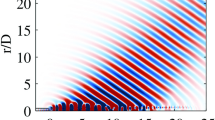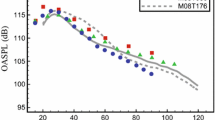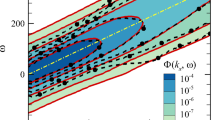Abstract
This study explores coherent structures in a swirling turbulent jet. Stationary axisymmetric solutions of the Reynolds–Averaged Navier–Stokes equations at \(Re=200,000\) were obtained using an open source computational fluid dynamics code and the Spalart–Allmaras eddy viscosity model. Then, resolvent analysis with the same eddy viscosity field provided coherent structures of the turbulent fluctuations on the base flow. As in many earlier studies, a large gain separation is identified between the optimal and sub-optimal resolvent modes, permitting a focus on the most amplified response mode and its corresponding optimal forcing. At zero swirl, the results indicate that the jet’s coherent response is dominated by axisymmetric (\(m=0\)) structures, which are driven by the usual Kelvin–Helmholtz shear amplification mechanism. However, as swirl is increased, different coherent structures begin to dominate the response. For example, double and triple spiral (\(|m|=2\) and \(|m|=3\)) modes are identified as the dominant structures when the axial and azimuthal velocity maxima of the base flow are comparable. In this case, distinct co- and counter-rotating \(|m|=2\) modes experience vastly different degrees of amplification. The physics of this selection process involve several amplification mechanisms contributing simultaneously in different regions of the mode. This is analysed in more detail by comparing the alignment between the wavevector of the dominant response mode and the principal shear direction of the base flow. Additional discussion also considers the development of structures along the exterior of the jet nozzle.
Graphical abstract




















Similar content being viewed by others
References
Abreu, L.I., et al.: Resolvent modelling of near-wall coherent structures in turbulent channel flow. Int. J. Heat Fluid Flow 85, 108662 (2020). https://doi.org/10.1016/j.ijheatfluidflow.2020.108662
Alnæs, M., et al.: Unified form language: a domain-specific language for weak formulations of partial differential equations. ACM Trans. Math. Softw. 40(2), 9:1-9:37 (2014). https://doi.org/10.1145/2566630
Amestoy, P.R., Duff, I.S., et al.: A fully asynchronous multifrontal solver using distributed dynamic scheduling. SIAM J. Matrix Anal. Appl. 23(1), 15–41 (2001)
Amestoy, P.R., Guermouche, A., et al.: Hybrid scheduling for the parallel solution of linear systems. Parallel Comput. 32(2), 136–156 (2006)
Balay, S., Abhyankar, S., et al.: PETSc/TAO Users Manual. Tech. rep. ANL-21/39 - Revision 3.19. Argonne National Laboratory (2023)
Balay, S., Gropp, W., et al.: Efficient management of parallelism in object oriented numerical software libraries. In: Arge, E., Bruaset, A.M., Langtangen, H.P. (eds.) Modern Software Tools in Scientific Computing, pp. 163–202. Birkhäuser Press, Basel, CH (1997)
Balay, S., Abhyankar, S., et al.: PETSc Web page. https://petsc.org/ (2023)
Batchelor, G.K., Gill, A.E.: Analysis of the stability of axisymmetric jets. J. Fluid Mech. 14(4), 529–551 (1962). https://doi.org/10.1017/S0022112062001421
Beneddine, S., et al.: Conditions for validity of mean flow stability analysis. J. Fluid Mech. 798, 485–504 (2016). https://doi.org/10.1017/jfm.2016.331
Billant, P., Chomaz, J.M., Huerre, P.: Experimental study of vortex breakdown in swirling jets. J. Fluid Mech. 376, 183–219 (1998). https://doi.org/10.1017/S0022112098002870
Billant, P., Gallaire, F.: Generalized Rayleigh criterion for non-axisymmetric centrifugal instabilities. J. Fluid Mech. 542, 365–379 (2005). https://doi.org/10.1017/S0022112005006464
Billant, P., Gallaire, F.: A unified criterion for the centrifugal instabilities of vortices and swirling jets. J. Fluid Mech. 734, 5–35 (2013). https://doi.org/10.1017/jfm.2013.460
Bodony, D.J., Fikl, A., Murthy S.: Adjoint-based sensitivity of shock-laden flows. In: 15th Ercoftac. Progress in Flow Instability, Transition and Control (2023)
Boyd, J.P.: Chebyshev and Fourier Spectral Methods: Second Revised Edition. Google-Books-ID: i9UoAwAAQBAJ. Courier Corporation (2001)
Chevalier, Q.: Coherent structures in turbulent flows, Ph.D. thesis. Institut Polytechnique doctoral school (2023)
Chevalier, Q., Lutz, L., Cavalieri, A.V.: A second-order resolvent formulation for the analysis of turbulent flow structures. Comptes Rendus. Mécanique 351(G2), 355–371 (2023). https://doi.org/10.5802/crmeca.193
Dalcin, L., et al.: Parallel distributed computing using Python. Adv. Water Resour. New Comput. Methods Softw. Tools 34(9), 1124–1139 (2011). https://doi.org/10.1016/j.advwatres.2011.04.013
Douglas, C.M., Emerson, B.L., Lieuwen, T.C.: Nonlinear dynamics of fully developed swirling jets. J. Fluid Mech. 924, A14 (2021). https://doi.org/10.1017/jfm.2021.615
Drazin, P.G., Reid, W.H.: Hydrodynamic Stability. Cambridge University Press, Cambridge (1982)
Duck, P.W.: The inviscid stability of swirling flows: large wavenumber disturbances. Z. Angew. Math. Phys. 37(3), 340–360 (1986). https://doi.org/10.1007/BF00946755
Ellingsen, T., Palm, E., et al.: Stability of linear flow. Phys. Fluids 18(4), 487–488 (1975). https://doi.org/10.1063/1.861156
Emanuel, K.A.: A note on the stability of columnar vortices. J. Fluid Mech. 145, 235–238 (1984). https://doi.org/10.1017/S0022112084002895
Gallaire, F., Rott, S., Chomaz, J.-M.: Experimental study of a free and forced swirling jet. Phys. Fluids 16(8), 2907–2917 (2004). https://doi.org/10.1063/1.1758171
Gallaire, F., Chomaz, J.-M.: Instability mechanisms in swirling flows. Phys. Fluids 15(9), 2622–2639 (2003). https://doi.org/10.1063/1.1589011
Gallaire, F., Chomaz, J.-M.: Mode selection in swirling jet experiments: a linear stability analysis. J. Fluid Mech. 494, 223–253 (2003). https://doi.org/10.1017/S0022112003006104
Garnaud, X.: Modes, transient dynamics and forced response of circular jets. Ph.D. thesis. Ecole Polytechnique X (2012)
Garnaud, X., et al.: The preferred mode of incompressible jets: linear frequency response analysis. J. Fluid Mech. 716, 189–202 (2013). https://doi.org/10.1017/jfm.2012.540
Geuzaine, C., Remacle, J.F.: Gmsh: a 3-D finite element mesh generator with built-in pre- and post-processing facilities. Int. J. Numer. Methods Eng. 79(11), 1309–1331 (2009). https://doi.org/10.1002/nme.2579
Hernandez, V., Roman, J.E., Vidal, V.: SLEPc: a scalable and flexible toolkit for the solution of eigenvalue problems. ACM Trans. Math. Softw. 31(3), 351–362 (2005). https://doi.org/10.1145/1089014.1089019
Howard, L.N., Gupta, A.S.: On the hydrodynamic and hydromagnetic stability of swirling flows. J. Fluid Mech. 14(3), 463–476 (1962). https://doi.org/10.1017/S0022112062001366
Khorrami, M.R.: On the viscous modes of instability of a trailing line vortex. J. Fluid Mech. 225, 197–212 (1991). https://doi.org/10.1017/S0022112091002021
Khorrami, M.R.: Stability of a compressible axisymmetric swirling jet. AIAA J. 33(4), 650–658 (1995). https://doi.org/10.2514/3.12627
Leibovich, S., Stewartson, K.: A sufficient condition for the instability of columnar vortices. J. Fluid Mech. 126, 335–356 (1983). https://doi.org/10.1017/S0022112083000191
Lessen, Martin, Paillet, F.: The stability of a trailing line vortex. Part 2. Viscous theory. J. Fluid Mech. 65(4), 769–779 (1974). https://doi.org/10.1017/S0022112074001649
Lessen, M., Singh, P.J., Paillet, F.: The stability of a trailing line vortex. Part 1. Inviscid theory. J. Fluid Mech. 63(4), 753–763 (1974). https://doi.org/10.1017/S0022112074002175
Lesshafft, L., et al.: Resolvent-based modelling of coherent wave packets in a turbulent jet. Phys. Rev. Fluids 4(6), 063901 (2019)
Liang, H., Maxworthy, T.: An experimental investigation of swirling jets. J. Fluid Mech. 525, 115–159 (2005). https://doi.org/10.1017/S0022112004002629
Loiseleux, T., Chomaz, J.-M., Huerre, P.: The effect of swirl on jets and wakes: linear instability of the Rankine vortex with axial flow. Phys. Fluids 10(5), 1120–1134 (1998). https://doi.org/10.1063/1.869637
Loiseleux, T., Delbende, I., Huerre, P.: Absolute and convective instabilities of a swirling jet/wake shear layer. Phys. Fluids 12(2), 375–380 (2000). https://doi.org/10.1063/1.870315
Lu, G., Lele, S.K.: Inviscid instability of compressible swirling mixing layers. Phys. Fluids 11(2), 450–461 (1999). https://doi.org/10.1063/1.869861
Manoharan, K., et al.: A weakly nonlinear analysis of the processing vortex core oscillation in a variable swirl turbulent round jet. J. Fluid Mech. 884, A29 (2020). https://doi.org/10.1017/jfm.2019.903
Martin, J.E., Meiburg, E.: Numerical investigation of three dimensionally evolving jets under helical perturbations. J. Fluid Mech. 243(1), 457 (1992). https://doi.org/10.1017/S0022112092002787
Martin, J.E., Meiburg, E.: On the stability of the swirling jet shear layer. Phys. Fluids 6(1), 424–426 (1994). https://doi.org/10.1063/1.868041
Martin, J.E., Meiburg, E.: The nonlinear evolution of swirling jets. Meccanica 29(4), 331–341 (1994). https://doi.org/10.1007/BF00987568
Martin, J.E., Meiburg, E.: Nonlinear axisymmetric and three-dimensional vorticity dynamics in a swirling jet model. Phys. Fluids 8(7), 1917–1928 (1996). https://doi.org/10.1063/1.868971
Martin, J.E., Meiburg, E.: The growth and nonlinear evolution of helical perturbations in a swirling jet model. Eur. J. Mech. B Fluids 17(4), 639–651 (1998). https://doi.org/10.1016/S0997-7546(98)80017-4
Meliga, P., Gallaire, F., Chomaz, J.-M.: A weakly nonlinear mechanism for mode selection in swirling jets. J. Fluid Mech. 699, 216–262 (2012). https://doi.org/10.1017/jfm.2012.93
Moise, P., Mathew, J.: Hysteresis and turbulent vortex breakdown in transitional swirling jets. J. Fluid Mech. 915, A94 (2021). https://doi.org/10.1017/jfm.2021.118
Montagnani, D., Auteri, F.: Non-modal analysis of coaxial jets. J. Fluid Mech. 872, 665–696 (2019). https://doi.org/10.1017/jfm.2019.356
Morra, P., Nogueira, P.A.S., et al.: The colour of forcing statistics in resolvent analyses of turbulent channel flows. J. Fluid Mech. (2021). https://doi.org/10.1017/jfm.2020.802
Morra, P., Semeraro, O., et al.: Resolvent analysis: With or without eddy viscosity? ERCOFTAC Bull. 118, 20 (2019)
Nogueira, P.A.S., et al.: Large-scale streaky structures in turbulent jets. J. Fluid Mech. 873, 211–237 (2019). https://doi.org/10.1017/jfm.2019.365
Nogueira, P.A. S., et al.: Forcing statistics in resolvent analysis: application in minimal turbulent Couette flow. ar**v:2001.02576 [physics]. (visited on 11/06/2020) (2020)
Oberleithner, K., Paschereit, C.O., Wygnanski, I.: On the impact of swirl on the growth of coherent structures. J. Fluid Mech. 741, 156–199 (2014). https://doi.org/10.1017/jfm.2013.669
Panda, J., McLaughlin, D.K.: Experiments on the instabilities of a swirling jet. Phys. Fluids 6(1), 263–276 (1994). https://doi.org/10.1063/1.868074
Pickering, E., et al.: Lift-up, Kelvin-Helmholtz and Orr mechanisms in turbulent jets. J. Fluid Mech. 896, A2 (2020). https://doi.org/10.1017/jfm.2020.301
Rayleigh, L.: On the dynamics of revolving fluids on JSTOR. In: Proceedings of the Royal Society of London, vol. 93. Containing Papers of a Mathematical and Physical Character A. Royal Society, London, pp. 148–154 (1917)
Rayleigh, L.: On the question of the stability of the flow of fluids. Lond. Edinb. Dublin Philos. Mag. J. Sci. 34(206), 59–70 (1892). https://doi.org/10.1080/14786449208620167
Roman, J.E., et al.: SLEPc Users Manual. Tech. rep. DSIC-II/24/02-Revision 3.20. D. Sistemes Informatics i Computació, Universitat Politecnica de Valencia (2023)
Schmid, P.J.: Nonmodal stability theory. Ann. Rev. Fluid Mech. 39(1), 129–162 (2007). https://doi.org/10.1146/annurev.fluid.38.050304.092139
Schmidt, O.T., et al.: Spectral analysis of jet turbulence. J. Fluid Mech. 855, 953–982 (2018). https://doi.org/10.1017/jfm.2018.675
Scroggs, M., Baratta, I., et al.: Basix: a runtime finite element basis evaluation library. J. Open Sour. Softw. 7(73), 3982 (2022). https://doi.org/10.21105/joss.03982
Scroggs, M., Dokken, J., et al.: Construction of arbitrary order finite element degree-of-freedom maps on polygonal and polyhedral cell 35 meshes. ACM Trans. Math. Softw. 48(2), 18:1-18:23 (2022). https://doi.org/10.1145/3524456
Semeraro, O., et al.: Modeling of coherent structures in a turbulent jet as global linear instability wave packets: theory and experiment. Int. J. Heat Fluid Flow 62, 24–32 (2016). https://doi.org/10.1016/j.ijheatfluidflow.2016.10.010
Spalart, P., Allmaras, S.: A one-equation turbulence model for aerodynamic flows. In: 30th Aerospace Sciences Meeting and Exhibit, p. 439. American Institute of Aeronautics and Astronautics (1992). https://doi.org/10.2514/6.1992-439
Synge, L.J.: The stability of heterogeneous liquids. Trans. R. Soc. Can. 27, 1 (1938)
Tempelmann, D., et al.: Swept wing boundary-layer receptivity to localized surface roughness. J. Fluid Mech. 711, 516–544 (2012). https://doi.org/10.1017/jfm.2012.405
The OpenFOAM Foundation (n.d.). https://openfoam.org/
Towne, A., Schmidt, O.T., Colonius, T.: Spectral proper orthogonal decomposition and its relationship to dynamic mode decomposition and resolvent analysis. J. Fluid Mech. 847, 821–867 (2018)
Zhang, J., et al.: The PetscSF scalable communication layer. IEEE Trans. Parallel Distrib. Syst. 33(4), 842–853 (2022)
Funding
This work has received funding from the European Union’s Horizon 2020 research and innovation programme under the CleanSky2 Joint Undertaking Grant Agreement No. 785303, and under the Marie Skłodowska-Curie Grant Agreement No. 899987. The first author has been supported by the Direction Générale de l’Armement. Results reflect only the authors’ view and none of the above are responsible for any use that may be made of the information it contains.
Author information
Authors and Affiliations
Corresponding author
Ethics declarations
Data availibility statement
The data used in this study may be requested from the authors.
Ethical approval
Not applicable.
Conflict of interest
The authors have no relevant financial or non-financial conflict of interest to disclose.
Additional information
Communicated by Kilian Oberleithner.
Publisher's Note
Springer Nature remains neutral with regard to jurisdictional claims in published maps and institutional affiliations.
Appendices
Validation case
In this section results from the code developed internally for the purposes of this study will be compared to known publications. The emphasis here is therefore proving the validity of design choices outlined in Sects. 2.1, 2.2.1 and 2.3.2, not introducing new phenomena. To increase confidence in our model, reproductions of figure 3(a) and 7(a) of Meliga et al. [47], as well as figure 6.6 from Garnaud [26] were made. They will not be discussed here for the sake of brevity, but may be found in Chevalier [15].
The case considered instead is closer to the one described in Sect. 2.1, namely the non-swirling jet based on Pickering et al. [56]. To better compare with the reference, the nozzle was cut out and calculations performed on \(x\in [0;49]\). Figure 20 is to be compared with Fig. 4b of that work. This graph differs notably from its reference - gains are lower than expected, the peak of the \(m=0\) curve happens at a higher frequency, and the other curves have a marked increase before the expected monotonic decrease.
However, there are several points where our model substantially differs from the reference:
-
Base flows come from different methods—one is the result of a LES calculation, the other a RANS process,
-
Eddy viscosity models also differ, one being a length scale model and the other being the SA model—even though qualitatively similar, they vary by about a factor three.
A qualitative comparison of response and forcing modes was also done on Fig. 21, which is to be compared to figures 9(b) and (c) of Pickering et al. [56]. These structures are qualitatively very close to the reference, though somewhat shorter. This is probably due to a difference in the eddy viscosity used, which leads to different localised dam**. It can be observed that the eddy viscosity used in this study steadily increases with x whereas that of Pickering et al. [56] peaks and eventually decays.
Resolvent modes for \((m,St)\in \{0,1,3\}\times \{0.05,0.2,0.6\}\). Scaling is adjusted to facilitate comparaison to Pickering et al.[56]
Mesh refinement
As part of the validation process of the code used in this work, convergence with respect to mesh refinement was verified. In the usual manner, a very refined mesh was taken as reference, and it was checked that results do converge quickly to the fine mesh as the number of elements increases, see Fig. 22. Mesh refinement was also verified for fluctuations. Once more, this point will be omitted here and made available in Chevalier [16],
Rights and permissions
Springer Nature or its licensor (e.g. a society or other partner) holds exclusive rights to this article under a publishing agreement with the author(s) or other rightsholder(s); author self-archiving of the accepted manuscript version of this article is solely governed by the terms of such publishing agreement and applicable law.
About this article
Cite this article
Chevalier, Q., Douglas, C.M. & Lesshafft, L. Resolvent analysis of swirling turbulent jets. Theor. Comput. Fluid Dyn. (2024). https://doi.org/10.1007/s00162-024-00704-2
Received:
Accepted:
Published:
DOI: https://doi.org/10.1007/s00162-024-00704-2







